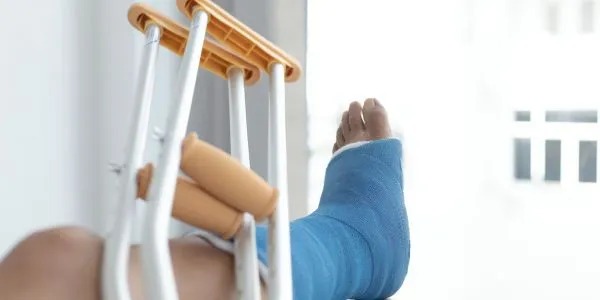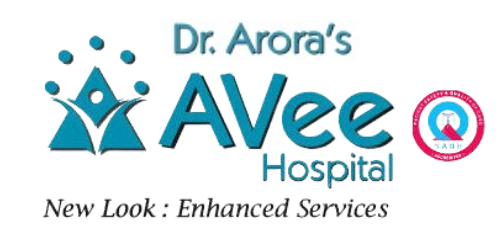Introduction
Bone fractures can happen to anyone, regardless of age or lifestyle. Whether from a fall, accident, or underlying medical condition, fractures require proper medical attention for optimal healing. AVEE Hospital is recognized as the best orthopedic hospital in Ghaziabad, offering comprehensive care for all types of bone fractures. Located in Vaishali Sector 6, AVEE Hospital provides expert treatment under the guidance of skilled specialists who understand the complexities of different fracture types.

Understanding bone fracture treatment options is key to proper healing. Treatment depends on the fracture type, location, severity, and your overall health. This quick guide outlines common fracture types and available treatments to help you make informed orthopedic care decisions.
Types of Fractures in Bones and Their Characteristics
Before exploring treatments, it’s essential to know the types of bone fractures, as each needs a specific approach for effective healing.
Closed vs. Open Fractures
Closed Fractures (Simple Fractures)
Closed fractures happen when the bone breaks without breaking through the skin. These fractures are less prone to infection since the skin barrier remains intact. While closed fractures can range from minor cracks to complete breaks, they generally have a lower risk of complications compared to open fractures.
Open Fractures (Compound Fractures)
Open fractures happen when the broken bone pierces through the skin, creating an open wound. These fractures require immediate medical attention due to the high risk of infection. The treatment for open fractures often involves cleaning the wound, administering antibiotics, and sometimes surgical intervention to prevent infection and promote proper healing.
Fracture Patterns
Transverse Fractures
Transverse fractures are straight breaks that occur perpendicular to the bone’s long axis. These fractures typically result from a direct impact or force applied to the bone. The bone fracture treatment options for transverse fractures often include immobilization with a cast or splint, though some cases may require surgical fixation.
Oblique Fractures
Oblique fractures run at an angle across the bone, often caused by twisting or angled impact. Treatment may involve casting or surgery with internal fixation, based on fracture stability.
Spiral Fractures
Spiral fractures, caused by twisting injuries, wrap around the bone and often occur in sports or falls. They usually need surgery for proper alignment and healing.
Comminuted Fractures
Comminuted fractures break the bone into three or more pieces, often from high-impact trauma. Surgery with internal fixation is usually required to rebuild the bone.
Special Types of Fractures
Greenstick Fractures
Greenstick fractures are incomplete breaks where the bone bends and cracks but doesn’t break all the way through partial breaks, similar to what happens when trying to break a green stick. These fractures are most common in children whose bones are more flexible. Treatment typically involves immobilization with a cast to allow the bone to heal properly.
Stress Fractures
Stress fractures are small cracks from repetitive force Caused by repetitive stress, often seen in athletes and active people. Treatment includes rest, activity changes, and sometimes immobilization.
Pathological Fractures
Pathological fractures occur in bones weakened by underlying conditions such as osteoporosis, bone cancer, or infection. These fractures can happen with minimal trauma or even during normal activities. Treatment addresses both the fracture and the underlying condition to prevent future fractures.
Avulsion Fractures
Avulsion fractures happen when a small bone fragment inked to a tendon or ligament is separated from the main bone. These fractures are common in athletes and typically affect areas where tendons or ligaments attach to bones. Treatment varies based on the size and location of the bone fragment.
Diagnosis of Bone Fractures
A precise diagnosis is vital for determining the appropriate right fracture treatment. At AVEE Hospital, the orthopedic surgeon in Ghaziabad performs a thorough evaluation that may include:
Physical Examination
The doctor will evaluate the injured area for signs of fracture, such as swelling, bruising, deformity, and sensitivity. They will also evaluate your range of motion and neurological function to determine if there’s any nerve damage.
Imaging Tests
Various imaging tests help confirm the diagnosis and determine the fracture’s exact location, type, and severity:
- X-rays: The most frequently used imaging test to diagnose fractures, providing clear images of most broken bones.
- CT Scans: Offer more detailed images, especially useful for complex fractures or those in areas with overlapping structures.
- MRI: Provides detailed images of soft tissues and can identify subtle fractures not visible on X-rays.
- Bone Scans: Help identify stress fractures and other injuries that might not show up on regular X-rays.
At AVEE Hospital, advanced diagnostics help the top orthopedic doctor in Ghaziabad create a personalized treatment plan for you.
Non-Surgical Bone Fracture Treatment Options
Many fractures can be treated without surgery, especially if the bone pieces are stable and properly aligned. AVEE Hospital offers various non-surgical broken bone treatments:
Immobilization
Casting
Casts are made of plaster or fiberglass and completely encircle the broken bone and the joints above and below the fracture. Casts provide rigid protection and immobilization, allowing the bone to heal in the correct position. Depending on the fracture type and location, a cast may need to be worn for 6-8 weeks.
Splinting
Splints provide less rigid immobilization than casts and are often used for less severe fractures or as a temporary measure before casting. They allow for swelling and can be adjusted as needed. Splints typically need to be worn for 3-5 weeks, depending on the fracture’s severity.
Functional Bracing
Functional braces allow some movement while providing support to the fractured bone. They’re often used in the later stages of healing or for certain fractures where early movement is beneficial. This approach can help prevent muscle atrophy and joint stiffness while still protecting the healing bone.
Closed Reduction
Closed reduction is a non-surgical method in which the doctor manually realigns the broken bone fragments without making an incision. This procedure is usually done under local or general anesthesia, based on the fracture’s complexity. After reduction, a cast or splint is applied to maintain the alignment during healing.
Medication Management
Pain management is an essential aspect of fracture treatment. Your doctor may recommend:
- Over-the-counter pain medications like acetaminophen or nonsteroidal anti-inflammatory drugs (NSAIDs) for mild to moderate pain.
- Prescription pain medications: For more severe pain, especially in the early stages of healing.
- Calcium and vitamin D supplements support bone healing, especially in patients with osteoporosis or weak bones.
Physical Therapy
Even with non-surgical treatment, physical therapy plays a crucial role in recovery. After the immobilization period, A well-designed rehabilitation program aids in restoring strength, flexibility, and function to the affected area. AVEE Hospital provides comprehensive rehabilitation services to ensure optimal recovery from fractures.
Surgical Fracture Treatment Options
For complex or unstable fractures, surgical intervention may be necessary. When searching for the best orthopedic hospital in Ghaziabad for surgical fracture treatment, AVEE Hospital stands out for its advanced surgical capabilities and experienced specialists.
Internal Fixation
Internal fixation involves surgically placing metal devices such as pins, screws, plates, or rods to hold the bone fragments in their proper position while they heal. This approach is commonly used for:
- Displaced fractures where the bone fragments need to be realigned
- Unstable fractures that cannot be adequately treated with casting alone
- Fractures involving joints where precise alignment is crucial for future function
- Multiple fractures or comminuted fractures requiring reconstruction
The internal fixation devices may be temporary or permanent, depending on the fracture type and the patient’s specific needs.
External Fixation
External fixation involves inserting pins or screws into the bone on either side of the fracture, with pins or screws attached to an external frame outside the body to stabilize the bone. This method is commonly used for:
- Open fractures with significant soft tissue damage
- Fractures with infection
- Complex fractures where internal fixation isn’t suitable
- Temporary stabilization before definitive surgery
External fixation allows for wound care and soft tissue management while providing stability to the fracture.
Bone Grafting
For fractures with bone loss or poor healing, bone grafting may be needed. It uses bone from the body, donors, or synthetic materials to fill gaps and promote healing, often combined with internal fixation for stability.
Joint Replacement
Severe joint fractures, especially in older patients with joint disease, may require joint replacement surgery. AVEE Hospital specializes in these surgeries, restoring function, reducing pain, and improving mobility.
Recovery and Rehabilitation After Fracture Treatment
No matter the treatment method, proper recovery and rehabilitation are crucial for effective healing and restoring function. Bone healing usually occurs in several stages:
- Inflammation Phase (Days 1-5): Blood clot formation and initial inflammatory response.
- Soft Callus Formation (Weeks 1-3): Development of cartilage around the fracture site.
- Hard Callus Formation (Weeks 3-12): Replacement of cartilage with woven bone.
- Bone Remodeling (Months to Years): Gradual reshaping and strengthening of the healed bone.
Physical Therapy and Rehabilitation
Physical therapy after fracture is crucial for restoring strength, flexibility, and function. A comprehensive rehabilitation program typically includes:
· Range of motion exercises help prevent joint stiffness and improve mobility.
- Strengthening exercises: To rebuild muscle strength around the fracture site.
- Balance and coordination training: To enhance stability and reduce the risk of falls.
- Functional training: To support your return to daily activities and sports.
AVEE Hospital’s rehabilitation team works closely with patients to develop personalized recovery plans based on their specific fracture type, treatment, and lifestyle goals.
Nutrition for Bone Healing
Proper nutrition supports bone healing. Key nutrients include:
- Calcium: Essential for bone formation and strength.
- Vitamin D: Aids the body in absorbing and utilizing calcium.
- Protein: Supplies essential nutrients for tissue repair.
- Vitamin C: Supports collagen formation and soft tissue healing.
- Zinc and Magnesium: Play important roles in bone metabolism and healing.
Your doctor might suggest dietary adjustments or supplements to promote better healing.
What to Expect After Knee Replacement: Recovery Timeline
For patients undergoing knee replacement surgery at AVEE Hospital, understanding what to expect after knee replacement helps prepare for the recovery journey. The best orthopedic doctor in Ghaziabad guides patients through a recovery timeline that typically follows these stages:
Immediate Post-Surgery (Day 1-3)
- Hospital Stay: Typically 1-3 days, depending on your progress.
- Pain Management: Drugs to manage pain and reduce swelling.
- Initial Mobility: Standing and walking with assistance, often on the same day as surgery.
- Basic Exercises: Simple movements to maintain blood flow and prevent stiffness.
Early Recovery (Weeks 1-3)
- Home Transition: Adapting your living space for safety and convenience.
- Physical Therapy: Regular sessions to improve range of motion and strength.
- Assistive Devices: Using a walker or crutches, gradually transitioning to a cane.
- Pain Management: Gradual reduction in pain medication as healing progresses.
Mid-Recovery (Weeks 4-6)
- Increased Mobility: Walking longer distances with less support.
- Expanded Exercises: More challenging strengthening and flexibility exercises.
- Daily Activities: Resuming light household activities and self-care.
- Driving: Possibly resuming driving if you have adequate control and are not taking narcotic pain medications.
Long-Term Recovery (Months 2-12)
- Continued Improvement: Gradual increase in strength, endurance, and function.
- Return to Activities: Phased return to low-impact activities like swimming, cycling, and golf.
- Follow-up Appointments: Regular check-ups to monitor progress and address any concerns.
- Full Recovery: Most patients achieve maximum improvement within 6-12 months.
Patients often ask about recovery after knee replacement. At AVEE Hospital, the rehab team offers expert guidance and support to ensure the best outcomes.
Conclusion: Getting the Right Care for Bone Fractures
Understanding the various bone fracture treatment options is the first step toward proper healing and recovery. Whether you’re dealing with a simple fracture that requires only immobilization or a complex break needing surgical intervention, getting expert care is essential for optimal outcomes.
AVEE Hospital provides comprehensive fracture treatment options for all types of bone injuries. As the best orthopedic hospital in Ghaziabad, AVEE Hospital combines advanced medical technology with experienced specialists to deliver exceptional orthopedic care. From accurate diagnosis to personalized treatment and comprehensive rehabilitation, the hospital’s integrated approach ensures that patients Get the support they need every step of the way during their recovery.
If you or a loved one has suffered a bone fracture, don’t delay seeking professional care. Contact AVEE Hospital in Vaishali Sector 6, Ghaziabad, to book an appointment with an orthopedic specialist. With proper treatment and professional care, you can expect a smooth and successful recovery return to your normal activities.
Keep in mind, effective treatment and rehabilitation are essential for preventing long-term complications and ensuring optimal function after a fracture. Trust the experts at AVEE Hospital to guide you through the healing process with compassion, expertise, and personalized care.

